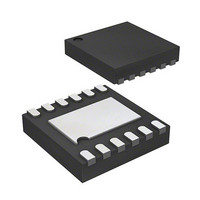MIC23060-G4YMT TR Micrel Inc, MIC23060-G4YMT TR Datasheet - Page 12

MIC23060-G4YMT TR
Manufacturer Part Number
MIC23060-G4YMT TR
Description
IC POWER MGMT SEQUENCE 12TMLF
Manufacturer
Micrel Inc
Datasheet
1.MIC23060-G4YMT_TR.pdf
(15 pages)
Specifications of MIC23060-G4YMT TR
Applications
Power Supply Sequencer
Voltage - Supply
2.7 V ~ 5.5 V
Current - Supply
43µA
Operating Temperature
-40°C ~ 125°C
Mounting Type
Surface Mount
Package / Case
12-TMLF®
Lead Free Status / RoHS Status
Lead free / RoHS Compliant
Other names
576-3650-2
MIC23060-G4YMT TR
MIC23060-G4YMT TR
The figure above shows an efficiency curve. From no
load to 100mA, efficiency losses are dominated by
quiescent current losses, gate drive and transition
losses. By using the HyperLight Load™ mode, the
MIC23060 is able to maintain high efficiency at low
output currents.
Over 100mA, efficiency loss is dominated by MOSFET
R
will increase the Gate-to-Source drive at the internal
MOSFETs, thereby reducing the internal R
improves efficiency by reducing DC losses in the device.
All but the inductor losses are inherent to the device. In
which case, inductor selection becomes increasingly
critical in efficiency calculations. As the inductors are
reduced in size, the DC resistance (DCR) can become
quite significant. The DCR losses can be calculated as
follows:
From that, the loss in efficiency due to inductor
resistance can be calculated as follows:
Efficiency loss due to DCR is minimal at light loads and
gains significance as the load is increased. Inductor
selection becomes a trade-off between efficiency and
size in this case.
HyperLight Load™ Mode
MIC23060 uses a minimum on and off time proprietary
control loop (patented by Micrel). When the output
voltage falls below the regulation threshold, the error
comparator begins a switching cycle that turns the
PMOS on and keeps it on for the duration of the
minimum-on-time. This increases the output voltage. If
Micrel, Inc.
April 2010
DSON
Efficiency
and inductor losses. Higher input supply voltages
DCR Loss = I
_Loss
100
90
80
70
60
50
40
30
20
10
0
0.1
OUT
=
v s. Output Current
OUT PUT CURRENT (mA)
DC/DC Efficiency
V
IN
1
⎡
⎢
⎢
⎣
=3.6V
1
2
X
−
V
DCR
IN
⎛
⎜
⎜
⎝
=5V
V
10
V
OUT
IN
=3V
V
OUT
×
100
I
OUT
×
I
1000
OUT
+
L_P
DSON
D
⎞
⎟
⎟
⎠
⎤
⎥
⎥
⎦
. This
×
100
12
the output voltage is over the regulation threshold, then
the error comparator turns the PMOS off for a minimum-
off-time until the output drops below the threshold. The
NMOS acts as an ideal rectifier that conducts when the
PMOS is off. Using a NMOS switch instead of a diode
allows for lower voltage drop across the switching device
when it is on. The asynchronous switching combination
between the PMOS and the NMOS allows the control
loop to work in discontinuous mode for light load
operations. In discontinuous mode, the MIC23060 works
in pulse frequency modulation (PFM) to regulate the
output. As the output current increases, the off-time
decreases, thus provides more energy to the output.
This switching scheme improves the efficiency of
MIC23060 during light load currents by only switching
when it is needed. As the load current increases, the
MIC23060 goes into continuous conduction mode (CCM)
and switches at a frequency centred at 4MHz. The
equation to calculate the load when the MIC23060 goes
into continuous conduction mode may be approximated
by the following formula:
As shown in the previous equation, the load at which
MIC23060 transitions from HyperLight Load™ mode to
PWM mode is a function of the input voltage (V
output voltage (VOUT), duty cycle (D), inductance (L)
and frequency (f). As shown in the figure below, as the
Output Current increases, the switching frequency also
increases until the MIC23060 goes from HyperLight
Load™ mode to PWM mode at approximately 120mA.
The MIC23060 will switch at a relatively constant
frequency around 4MHz once the output current is over
120mA.
I
LOAD
10000
1000
>
100
0.1
10
1
⎛
⎜ ⎜
⎝
1E-05 0.0001 0.001
(
V
IN
Switching Frequency
2
−
v s. Load Current
L=2.2µH
×
LOAD CURRENT (A)
V
L
OUT
×
L=1µH
f
)
×
L=0.47µH
0.01
D
⎞
⎟ ⎟
⎠
0.1
M9999-042210-B
1
MIC23060
DVIN
),






